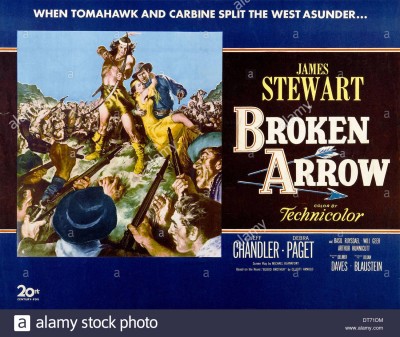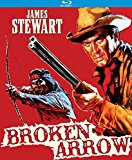| Reviews & Columns |
|
Reviews DVD TV on DVD Blu-ray 4K UHD International DVDs In Theaters Reviews by Studio Video Games Features Collector Series DVDs Easter Egg Database Interviews DVD Talk Radio Feature Articles Columns Anime Talk DVD Savant Horror DVDs The M.O.D. Squad Art House HD Talk Silent DVD
|
DVD Talk Forum |
|
|
| Resources |
|
DVD Price Search Customer Service #'s RCE Info Links |
|
Columns
|
|
|
Broken Arrow
It's a film about Indians in which the two leading Native American characters are played by whites, Brooklyn-born Jeff Chandler and Denver-born Debra Paget. Some of the details about Apache life are fictitious, including the "Apache Wedding Prayer," which is often read at weddings as if it were authentic, despite being created by blacklisted screenwriter Albert Maltz specifically for this movie.
Nevertheless, Broken Arrow is fundamentally honest where it counts, and was light years ahead of most big studio films of the time, let alone Westerns. It's a film in which whites and Indians alike are prejudiced, capable of brutal violence against innocent people, fearful of "the other" and to whom trust and co-existence with people different than themselves does not come easy. Broken Arrow is a plea for tolerance and understanding, but it's also a great drama with much tense action, and it offers one of the screen's great love stories.
The movie begins with narration by Stewart worth quoting in full: "This is the story of a land, of the people who lived on it in the year 1870, and of a man whose name was Cochise. He was an Indian - leader of the Chiricahua Apache tribe. I was involved in the story and what I have to tell happened exactly as you'll see it - the only change will be that when the Apaches speak, they will speak in our language. What took place is part of the history of Arizona and it began for me here where you see me riding."
This itself is startling. Stewart's character as former Union scout Tom Jeffords, explains that the story isn't about him, but rather the land and the famous Apache chief Cochise. Moreover, though the movie audience will hear all of the Apache dialogue in English, for much of the film Jeffords will be communicating with characters in the Apache language.
The story opens with Jeffords encountering a 14-year-old Apache boy, wounded by white man's buckshot and near death. Though frightened, Jeffords nurses the equally frightened boy back to health over several days. Apache warriors then appear out of nowhere, ready to kill Jeffords, but the boy persuades them to spare the white man. Just then, a group of gold wanders into the area, unaware of the Apaches' presence. They gag and hogtie Jeffords, fatally arrow the prospectors and gruesomely torture the survivors. ("They found a pouch on one of the wounded men, and in the pouch were three Apache scalps. So they dug a pit in the ground and they rubbed his face with the juice of the mescal plant. And they made me watch the ants come.") They let Jeffords go but warn him never to enter Apache territory again.
Returning to Tucson, Jeffords tells his story to incredulous townsfolk, most outraged that he didn't kill the wounded boy outright. Local rancher Ben Slade (Will Geer), whose ranch was recently burned and his wife killed, is particularly aghast. Jeffords is offered a position with the U.S. Cavalry to help exterminate the Apache, but he's had enough killing. Instead he learns the Apache language and its customs from a local Indian. Against the advice of all, Jeffords intends to meet Cochise face-to-face and work toward a peace treaty.
Jeffords's appearance at the Apache stronghold surprises Cochise (Jeff Chandler), whom Jeffords's learn is a fair and just man, though understandably suspicious of the white intruder's intensions. As a show of good faith Cochise agrees to allow mail couriers to pass through Apache territory unmolested. When that succeeds, they further bargain with General Oliver Otis Howard (Basil Ruysdael) a formal peace treaty, though a faction of a Apache leaders, led by Geronimo (Jay Silverheels), oppose this.
Meanwhile, Jeffords has fallen in love with a young Apache girl, Sonseeahray (Debra Paget, just 15 when filming began), and she with him.
Broken Arrow is remarkably forward-thinking on many levels. It's not just that the Apache are depicted sympathetically. Rather, they are seen not as a faceless warrior mob but as people much like us, some good, even great like Cochise, others bad, just like the fearful men of Tucson. When the wounded boy talks of his mother crying for him back at their camp, Jeffords is taken aback. He'd never imagined an Apache woman crying for her missing boy. In one sense, Broken Arrow is about suffering endured by both sides, the price that must be paid by all before a lasting peace can transpire. Whites and Apache alike talk of losing loved ones and their bitterness and mistrust of the other. Whites kill innocent Apache and Apache kill innocent whites. Jeffords, in one sense, is brave and determined, reasonable but naïve. When he himself pays dearly at the film's climax, he's briefly as bloodthirsty as the movie audience is at that moment. "To talk of peace is not hard," Cochise cautioned him, "To live it is very hard."
Movies depicting interracial love were almost unheard of in 1950, certainly not since the silent and early, Pre-Code Hollywood talkie days. In Broken Arrow, Maltz's romance between Jeffords and Sonseeahray is so heartfelt and natural that any objection to it seem absurd. What sells it is the sincerity of Stewart's and Paget's performances and Paget's unique mix of innocence and exoticism, a mixture that led to her typecasting in such roles. (Blue-eyed, she wears brown contact lenses, which accidentally add to her character's effectiveness. When she looks into Jeffords's eyes it's like she gazing into his soul.)
Stewart, who'd struggled to rebuild his movie career after the war, found a niche playing psychologically tested or scarred characters, particularly in movies for Alfred Hitchcock and in Westerns for Anthony Mann, but also in other films like No Highway in the Sky and in Billy Wilder's The Spirit of St. Louis. His performance in Broken Arrow is superb, really two in one. He's careful and methodical, reasonable and honest in working with Cochise, which makes his final scene all the more gut wrenching. With Sonseeahray he's playful yet sincere, aware of the myriad problems an interracial romance will bring to him and his intended wife, yet steadfast in his refusal to deny it. It's one of the great performances in a Western film.
Broken Arrow impresses in many other ways as well. Watching it for probably the seventh or eighth time through the years, I was particularly struck by Hugo Friedhofer's musical score. Rather, I most admired Friedhofer's intelligence on where not to underscore the action onscreen. Even many of the great composers of the era tended toward wall-to-wall scoring (e.g., Alex North's music for Spartacus) when silence can be far more effective. Friedhofer's music, particularly for the love scenes between Sonseeahray and Jeffords, is lovely, but in leaving several major scenes without music, he greatly enhances the film's power.
Video & Audio
Broken Arrow was photographed in three-strip Technicolor, for 1.37:1 standard exhibition. The color in this high-def transfer is undeniably rich, but I was surprised by how frequently misaligned the color matrixes were, resulting in a frequent unnecessary blurriness on-and-off throughout. It's no deal-breaker, but presumably it's something that could be fixed, and should have. The DTS-HD Master Audio mono (English only with optional subtitles) is fine on this Region A encoded disc.
Extras
Supplements are limited to a trailer and two brief Fox Movietone newsreel clips, one of Stewart and Paget unveiling a 50-star American flag prior to Alaska and Hawaii's eventual statehood. It's a bit surprising with scholars climbing over one another to provide commentary tracks and other content for the more obscure sci-fi and horror films, there wasn't an equally mad rush to supply extras for such a seminal Western, but apparently not.
Parting Thoughts
Light on extras, and an imperfect high-def transfer, but Broken Arrow is one of the greatest Western films of all-time, a must-see and therefore Highly Recommended.
Stuart Galbraith IV is the Kyoto-based film historian largely absent from reviewing these days while he restores a 200-year-old Japanese farmhouse.
|
| Popular Reviews |
| Sponsored Links |
|
|
| Sponsored Links |
|
|
| Release List | Reviews | Shop | Newsletter | Forum | DVD Giveaways | Blu-Ray | Advertise |
|
Copyright 2024 DVDTalk.com All Rights Reserved. Legal Info, Privacy Policy, Terms of Use,
Manage Preferences,
Your Privacy Choices | |||||||















